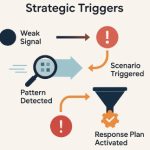Why AI Tech Adoption Fails — And How to Get It Right
Many companies are investing in AI and generative AI tools, such as Microsoft Copilot, Google Duet AI, Notion AI, and industry-specific assistants. But despite the promise of productivity and innovation, adoption often falls flat.
The reasons? They’re surprisingly consistent and avoidable.
The Problem: New Tech ≠ Guaranteed Results
Just because a tool is powerful doesn’t mean it will be used effectively. Even well-funded AI rollouts often fail to deliver a return on investment (ROI). Why?
- Licensing Before Learning
Many organizations purchase enterprise licenses in hopes that it will satisfy pressure to “do something with AI,” often driven by board-level mandates or competitive urgency. But instead of being guided by clear objectives or success metrics, these decisions are made reactively. For example, Microsoft Copilot costs $30 per user/month, and many firms find it underutilized because they skipped the strategic groundwork. The result: high costs, low impact, and unclear value.
- Lack of Ownership and Accountability
AI adoption often falls into a gray area: IT implements it, but business teams are supposed to use it. Without a designated owner or cross-functional sponsor, rollout efforts can lose momentum. No one is actually responsible for adopting metrics, training, iteration, or ensuring tools map to business outcomes.
- Generic Use Cases Miss the Mark
AI adoption only succeeds when the tools support everyday work. If users can’t connect a platform to their actual tasks — writing reports, drafting emails, summarizing meetings — they won’t see the point. Generic training doesn’t help finance, HR, legal, or marketing teams understand where the value lies.
- Awareness and Access Gaps
Employees may not even know they have access to new tools. Without a clear communication plan or onboarding process, many users don’t activate or try the product, leading to low engagement from day one.
- Skills Gaps: Prompting ≠ Intuition
While many companies aim to leverage generative AI as part of their broader AI strategy, they often overlook a crucial requirement: prompt literacy. Generative AI tools require users to learn a new skill — crafting effective prompts to get meaningful outputs. Without training, employees struggle to use tools like Copilot, Claude, or Gemini productively. This results in poor outcomes, user frustration, and ultimately, abandonment.
- Integration Friction
Even the most advanced AI tools struggle to gain traction if they don’t work well with the systems employees already use. If AI-generated content must be copied into a separate workflow, or if users constantly toggle between platforms, it adds friction. Integration challenges are especially common when tools aren’t embedded into CRMs, ERPs, or collaboration platforms.
- Change Fatigue and AI Skepticism
Many employees are already overwhelmed by frequent tech rollouts, tool updates, and shifting workflows. Without a clear connection to personal or organizational benefit, AI adoption may be met with apathy or quiet resistance. Some teams view AI as a passing trend or fear it as a job threat, primarily if messaging focuses on automation without emphasizing augmentation.
- Risk, Trust, and Compliance Concerns
Employees hesitate when guidelines are unclear. Can I share sensitive data? What if the answer is wrong? How will my manager react if I use this tool? Without governance and guardrails, adoption stalls are due to fear or misuse.
These issues turn promising technologies into cost centers, not performance drivers.
A Better Way: Strategy-First Adoption
Whether you’re piloting Microsoft Copilot, launching a custom GPT, or investing in an AI-powered platform, the right approach follows three phases:
Phase 1: Assess — Align with Business Goals
The first step is not buying technology — it’s defining what success looks like.
Align to Business Objectives
- What strategic goals is the company trying to achieve? (e.g., reduce time-to-market, improve customer retention, scale content output, make better decisions faster)
- How can AI serve those goals — and how will you measure it?
- Is leadership aligned on the “why” for this initiative?
Framing AI as a strategic enabler ensures that adoption efforts have direction — and that they can be clearly communicated across the organization.
Understand Use Cases and Readiness
- Conduct discovery interviews across teams to uncover pain points and unmet needs.
- Segment users by function or role to identify where AI can make the biggest day-to-day impact.
- Identify opportunities where AI can reduce effort, enhance insight, or increase speed.
Identify Champions and Risks
- Recruit early adopters and influencers to serve as advocates during rollout.
- Flag common concerns — like trust in outputs, data sensitivity, or job disruption — early in the process so they can be proactively addressed.
Phase 2: Pilot — Test, Learn, and Adjust
Don’t initially launch across the entire enterprise. Start with a targeted pilot designed to validate use cases and surface real-world challenges.
Design a High-Value Pilot
- Choose a cross-functional group (10–30 users) aligned to strategic goals.
- Focus on specific business processes, not generic testing.
- Include a mix of roles, levels, and tech proficiency.
Collect Feedback and Data
- Track what’s working, what’s unclear, and where usage stalls.
- Use structured feedback (interviews, surveys, usage analytics) to understand:
- What tasks does AI help with?
- Where does it fall short?
- What support would boost confidence and adoption?
Define Success Criteria
- Align pilot KPIs to your earlier business objectives (e.g., time saved, quality improved, satisfaction increased).
- Make the business case: show that AI can deliver tangible value.
Phase 3: Scale — Build Toward Enterprise Value
Once the pilot proves value and identifies gaps, it’s time to scale intentionally.
Tailor Enablement by Role
- Avoid one-size-fits-all training. Design materials by function (e.g., finance, HR, customer service) and by use case.
- Highlight real examples where the tool made a difference in day-to-day work.
Build a Self-Sustaining Ecosystem
- Provide on-demand resources (FAQs, prompt libraries, success stories).
- Create internal communities or “prompt clubs” for sharing best practices and learning.
Put Governance in Place
- Publish clear policies: what’s okay to share, how outputs should be validated, and when human oversight is required.
- Balance innovation with responsible use.
Why Business-Aligned Strategy Is Essential
When employees understand how AI connects to their goals — and how it helps the company achieve strategic outcomes — adoption becomes purposeful, not passive.
Successful organizations treat AI not as a feature, but as a force multiplier that helps:
- Increase efficiency without burnout
- Make better decisions faster
- Scale creativity and innovation
- Stay competitive in a fast-moving market
Bottom Line
If you’re investing in AI, don’t just launch a tool — launch a strategy.
Whether you’re deploying Microsoft Copilot or any AI platform, adoption only succeeds when it starts with business alignment, real use cases, and a roadmap to scale.
Not sure where to start?
Reach out to Kate Wade, Managing Director of Wade Strategy and founding partner at The AI Strategies Group (AISG), to explore how your organization can take the first strategic step toward responsible, practical, and profitable AI adoption.
To learn more, visit www.wadestrategy.com or connect with Kate at kate.wade@kwade.net.
#AIstrategy #ChangeManagement #DigitalTransformation #AIStrategy #GenAI #MidMarketGrowth #Copilot #BusinessInnovation #AIAdoption
Are you making costly assumptions in your strategy?
Most businesses don’t fail because of bad logic—they fail because they base their logic on assumptions that aren’t true.
Get our free Market Intelligence Guide
to uncover blind spots, assess your strategy, and build a system for smarter decisions.




